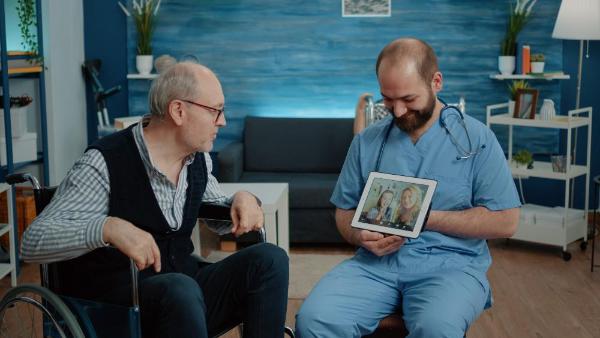6 Fall Prevention Measures to Implement in Assisted Living Homes
Many older adults enter assisted living facilities to maintain their quality of life as they age. However, they remain some of the most at-risk individuals for injuries related to falls. That’s because factors like age-related declines in mobility, vision impairments, and medication side effects are higher for them. In some cases, environmental hazards, insufficient staff training, and underutilization of technology contribute to residents’ fall-related injuries and a decline in their overall well-being.
As the population ages, it becomes more imperative for assisted living residences to implement effective fall prevention measures. This involves applying best practices to prevent falls as well as incorporating analog and technology solutions to reduce the risk of falls and mitigate their harmful effects. Let’s explore in detail a range of strategies designed to reduce the risk of falls in assisted living facilities.
Environmental Modifications for Fall Prevention
Effective fall prevention begins with making environmental modifications within assisted living facilities. This includes ensuring adequate lighting throughout the premises, particularly in hallways and common areas, to improve visibility and reduce the risk of tripping. It’s also a good idea to install nightlights or place lamps within reach of residents’ beds in case they need to get up in the middle of the night. Moreover, installing glow-in-the-dark or illuminated switches instead of traditional ones can also help residents find them more easily.
Additionally, removing potential hazards such as loose rugs, clutter, and uneven surfaces helps create a safer living environment. If there are loose, wooden floorboards and carpeting, fix or remove them right away. In case something spills, clean them up to prevent falls on slippery floors. Moreover, place nonslip mats in the toilet and shower.
Regular Staff Training and Education
Comprehensive training and education for assisted living staff are paramount to identifying residents at risk of falls and implementing appropriate preventive measures. That said, staff should receive regular training in fall prevention methodologies, including proper lifting and transfer techniques, as well as strategies for assisting residents with mobility challenges. Additionally, they should be trained to recognize early signs of fall risk in residents and to respond promptly and effectively to prevent falls from occurring. Moreover, regular updates and refreshers on fall prevention protocols ensure that assisted living staff remain vigilant and proactive in maintaining a safe living environment for residents.
Use of Assisted Living Transportation Software for Enhanced Response to Fall Incidents
Aside from adopting the best practices, tech tools also offer new opportunities to enhance non-critical fall prevention efforts in assisted living facilities. Assisted living transportation scheduling software, for example, streamlines communication between nursing home staff and emergency responders and healthcare providers, enabling residents to receive proper care or treatment in the fastest and most efficient manner possible.
In the event of a non-critical fall, staff can use the software to alert emergency responders, coordinate transportation to medical facilities, and easily provide vital information about the resident's condition and medical history. This streamlined approach helps minimize delays in accessing medical care and ensures that residents receive the timely and appropriate treatment they need to recover quickly and fully from the fall accident. Additionally, by tracking and documenting fall incidents, this tech tool allows staff to identify trends and implement targeted interventions to reduce the risk of future falls.
Implementation of Exercise and Physical Therapy Programs for Residents
Regular exercise and physical therapy play a crucial role in maintaining strength, balance, and mobility among elderly residents. As such, assisted living facilities should offer structured exercise programs tailored to the individual needs and abilities of residents. These programs may include strength training, balance exercises, and flexibility routines designed to improve overall physical function and reduce the risk of falls. Additionally, incorporating physical therapy sessions can help residents address specific mobility challenges and enhance their confidence in navigating their surroundings safely.
Effective Medication Management
Many medications prescribed to older adults can increase the risk of falls due to side effects such as dizziness, drowsiness, or changes in blood pressure. In this case, effective medication management is crucial. This includes conducting regular reviews of residents' medications to identify any potential interactions or adverse effects that may contribute to falls. Staff should also educate residents about the importance of taking medications as prescribed, and they should likewise be vigilant in monitoring for signs of medication-related side effects.
Utilization of Assistive Devices and Mobility Aids
For residents with mobility limitations, the use of assistive devices and mobility aids is instrumental in enhancing independence and reducing the risk of falls. Identify who these residents are and provide them with common aids such as canes, walkers, and wheelchairs, which provide stability and support. This way, residents can navigate their surroundings with greater confidence and security.
In addition to providing residents with suitable mobility aids, assisted living homes must have standardized equipment designed specifically to prevent falls in key areas. This includes handlebars strategically placed in hallways, stairwells, and bathrooms. Furthermore, staff must constantly reassess residents' mobility needs and ensure proper fitting and maintenance of these devices to maximize their effectiveness in fall prevention.
Conclusion
Fall prevention is a multifaceted endeavor that requires a comprehensive approach encompassing practical environmental modifications, continuous staff training, and the integration of technology solutions. Consider implementing these strategies along with other fall prevention efforts. By prioritizing the well-being of their residents, facilities and their staff can continue creating safe living environments for residents now and in the future.

